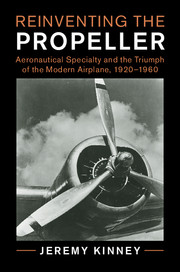Book contents
- Frontmatter
- Dedication
- Contents
- List of Figures
- List of Tables
- Preface
- Acknowledgments
- List of Abbreviations
- A Note on Terms
- 1 Introduction: The Propeller and the Modern Airplane
- 2 “The Best Propeller for Starting Is Not the Best for Flying”
- 3 “Engineering of a Pioneer Character”
- 4 A “New Type Adjustable-Pitch Propeller”
- 5 “The Propeller That Took Lindbergh Across”
- 6 “The Ultimate Solution of Our Propeller Problem”
- 7 No. 1 Propeller Company
- 8 A Gear Shift for the Airplane
- 9 Constant-Speed
- 10 “The Spitfire Now ‘Is an Aeroplane’ ”
- 11 A Propeller for the Air Age
- 12 Conclusion: The Triumph and Decline of the Propeller
- Essay on Sources
- Index
9 - Constant-Speed
Published online by Cambridge University Press: 20 April 2017
- Frontmatter
- Dedication
- Contents
- List of Figures
- List of Tables
- Preface
- Acknowledgments
- List of Abbreviations
- A Note on Terms
- 1 Introduction: The Propeller and the Modern Airplane
- 2 “The Best Propeller for Starting Is Not the Best for Flying”
- 3 “Engineering of a Pioneer Character”
- 4 A “New Type Adjustable-Pitch Propeller”
- 5 “The Propeller That Took Lindbergh Across”
- 6 “The Ultimate Solution of Our Propeller Problem”
- 7 No. 1 Propeller Company
- 8 A Gear Shift for the Airplane
- 9 Constant-Speed
- 10 “The Spitfire Now ‘Is an Aeroplane’ ”
- 11 A Propeller for the Air Age
- 12 Conclusion: The Triumph and Decline of the Propeller
- Essay on Sources
- Index
Summary
Millionaire aviator Howard R. Hughes and four crew members took off from Floyd Bennett Field, New York, in a Lockheed 14 Super Electra twin-engine transport on July 10, 1938. Three days, nineteen hours, and fourteen minutes later, the silver monoplane, named the New York World's Fair 1939, had covered 14,824 miles in a round-the-world flight that symbolized the imminent arrival of the futuristic “World of Tomorrow” that the exposition celebrated. The NAA awarded Hughes and his crew the 1938 Collier Trophy for their well-executed long-range flight that highlighted innovations in navigation, communications, and engineering and illustrated overall the superiority of American aeronautical technology. Hughes “praised highly” the two Hamilton Standard Hydromatic constant-speed propellers, which had only become available just a few months before the flight. Hughes's flight marked the arrival of a modern and refined airplane, propeller and all, in its most complete form.
Spectacular intercontinental flights such as Lindbergh's solo Atlantic crossing in 1927, the Uiver in the MacRobertson Race in 1934, and Hughes's around-the-world flight were indications that the aeronautical community expanded its conception of the synergistic system of the commercial and military airplane. Such spectacular uses of the airplane led many in the United States to believe that a new era in history, an Air Age of peace, unlimited progress, and opportunity for humankind, was just around the corner. The world's other aeronautical nations demonstrated the promise of aviation in different ways during the late 1930s. For Nazi Germany, the airplane was a potent technological symbol of fascism. Great Britain used commercial and military airplanes to connect its far-flung global empire.
The constant-speed propeller was a central technology in these modern airplanes. It was the ultimate form of a variable-pitch mechanism because it changed blade pitch automatically according to varying flight conditions while the engine speed remained the same, which maximized propeller, engine, and fuel economy and offered hands-off operation. Proposed first by Hele-Shaw and Beacham in 1924, not a single one had flown on an operational airplane in Europe or North America in the decade that followed. National aeronautical communities in the United States, Nazi Germany, and Great Britain approached this next step in different ways in the 1930s.
- Type
- Chapter
- Information
- Reinventing the PropellerAeronautical Specialty and the Triumph of the Modern Airplane, pp. 235 - 273Publisher: Cambridge University PressPrint publication year: 2017

